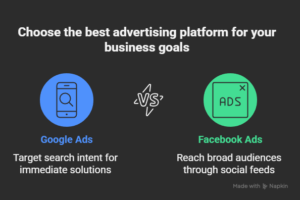Table of Contents
Every business wants more customers. What do you think Google Ads better than Facebook Ads? The choice is difficult. Both platforms generate traffic, and costs, target and outcome differ with each other. This article breaks it down with clear descriptions of costs, audience, and return on investment. This is a sample and tips that you might find useful. You know where the right platform – on a quick sale or brand growth path.
Google ads are finding people who need solutions. It’s called Facebook Ads and it grabs users from the social network. In terms of industry and goal, costs vary. When it comes to the price of a click, Google often costs more than it does Facebook, which is more than it is worth. Targeting is based on intent and interests. If you make investments you pay for the product and audience. Small businesses can start with one but combined can bring big winners. This includes comparisons, pros, cons and strategies on how to choose wisely.
Join Our Online Digital Marketing Course & Learn the Fundamentals!
What Are Google Ads?
Google Ads is a pay per click solution. You pay money if someone clicks your ad. It reflects ads they are getting for online. Ads appear at the top of or side of results when users type in a query.
These include search ads that appear in Google’s search results. Display ads on websites appear with images or text. YouTube ads are played before or during videos. The shopping ads provide price and images for products that are good for e-commerce.
Pros:
- Targets high-intent users ready to buy.
- Reaches billions of daily Google searches.
- Tracks clicks and sales with clear data.
- Offers flexible budgets for any size.
Cons:
- Costs more in competitive industries.
- Requires time to research keywords.
- Ads may be ignored if not relevant.
- Bidding wars increase expenses.
Google Ads began as AdWords in 2000. It grew with Google’s search engine, now handling trillions of searches yearly. A plumber bidding on “emergency plumber near me” gets calls fast. Online stores use shopping ads to drive direct sales. YouTube ads engage viewers with quick stories. This platform excels for businesses needing immediate leads from active searchers.
What Are Facebook Ads?
1: What is the primary goal of SEO (Search Engine Optimization)?
Facebook Ads is a social media advertising system. It charges for clicks or impressions. Ads target users based on their interests, behaviors, or demographics. They blend into social feeds as users scroll.
Key features include feed ads in main timelines, story ads in full-screen mobile stories, and carousel ads for swiping through multiple images. Video ads grab attention in feeds. Audience network ads extend to other apps for broader reach.
Pros:
- Targets precisely by age, location, or hobbies.
- Starts with low budgets, even $5 daily.
- Uses eye-catching visuals like images and videos.
- Retargets past website visitors effectively.
Cons:
- Users often browse, not buy.
- Ads compete with heavy social noise.
- Privacy rules limit targeting data.
- Requires ongoing testing for results.
Launched in 2007, Facebook Ads uses user data to match ads. A clothing brand targets young women who love fashion, showing trendy outfits. Restaurants promote local deals with mouthwatering photos. Events fill seats by targeting fans of similar activities. It’s ideal for building brand awareness and engaging communities, turning likes into loyal customers.
Become an AI-powered Digital Marketing Expert
Master AI-Driven Digital Marketing: Learn Core Skills and Tools to Lead the Industry!
Explore CourseGoogle Ads vs Facebook Ads: A Detailed Comparison
Both platforms drive traffic but work differently. The right choice depends on your business goals. Here’s how they stack up.
Targeting Capabilities
Google Ads uses intent-based targeting. Ads match keywords users search, like “best coffee maker.” Broad keywords reach more people; exact ones hit specific searches. You can refine by location, device, or language.
Facebook Ads targets by audience traits. Select users based on interests, like “yoga” or “parenting.” Choose age, gender, or location. Lookalike audiences find users similar to your customers. Custom lists target past buyers using email data.
Google shines for bottom-funnel leads ready to purchase. Facebook excels at top-funnel awareness, introducing your brand. A gym might use Google for “join gym now” searches and Facebook to reach fitness fans.
Cost Comparison
Costs depend on industry and campaign type. Google Ads averages $2.69 per click for search and $0.63 for display. Cost per thousand impressions (CPM) is $38.40 for search and $3.12 for display. Competitive fields like legal services hit $8.58 per click.
Facebook Ads averages $1.92 per click for lead generation and $0.70 overall. CPM is around $8.60, or $12.74 for e-commerce. Facebook often costs less for brand awareness, while Google’s higher costs suit high-intent leads.
Small businesses with tight budgets may prefer Facebook’s lower entry point. Google’s costs rise in niches like insurance or law. Testing both helps find what delivers best value.
ROI & Conversion Potential
Return on investment varies by goal. Google Ads often delivers higher ROI for urgent needs. A roofer targeting “fix leaky roof” gets calls from desperate homeowners. Conversion rates can hit 3-5% for search ads in high-intent niches.
Facebook Ads boosts awareness and engagement. A coffee shop running video ads about its cozy vibe may see 1-2% conversion but gain loyal followers. Retargeting past visitors lifts ROI, with 2-3 times higher click-through rates.
Case Study Example: A small e-commerce store selling eco-friendly bags used Google Ads for “sustainable backpacks.” They spent $500 and earned $2,000 in sales (4x ROI). On Facebook, they targeted eco-conscious millennials with carousel ads, spending $300 for $900 in sales (3x ROI). Google won for quick sales, but Facebook built a fanbase.
Audience Reach & Engagement
Google reaches billions daily through search. It captures users actively seeking solutions. A single search ad can hit thousands of relevant users in minutes.
Facebook has over 2.8 billion active users monthly. Ads engage people browsing socially, not searching. Visuals spark interest, and comments build community. Engagement rates average 0.9% on Facebook versus 0.6% for Google display ads.
Google suits products solving immediate problems. Facebook fits brands wanting to connect emotionally or retarget.
Ease of Use & Learning Curve
Google Ads setup involves picking keywords, writing ads, and setting bids. The platform offers tutorials, but mastering keyword strategy takes weeks. Tools like Google Keyword Planner help.
Facebook Ads Manager is user-friendly. Create ads, choose audiences, and set budgets in a visual interface. Learning takes days, with templates for beginners. Both platforms provide guides and community forums.
Small businesses may find Facebook easier to start. Google rewards effort with precise targeting.
Google Ads vs Facebook Ads: Comparison Table
| Factor | Google Ads | Facebook Ads |
| Targeting | Keywords, search intent | Interests, demographics, lookalikes |
| Cost | Higher CPC ($2.69 search, $0.63 display) | Lower CPC ($0.70-$1.92) |
| ROI | Best for high-intent leads | Best for awareness, retargeting |
| Audience | People searching for solutions | People browsing socially |
| Ease of Use | Moderate, needs keyword skills | Easy, visual interface |
Which One Is Better for Small Businesses?
Small businesses need results fast. The choice depends on goals.
Lead Generation: Google Ads wins. Target users searching for your service, like “local dentist.” A $200 budget can yield 50-100 clicks, with 2-5% converting to bookings.
Brand Awareness: Facebook Ads excels. Show vibrant ads to locals or hobbyists. A $100 budget can reach 10,000+ impressions, building recognition.
E-commerce: Both work. Google Shopping ads drive direct sales. Facebook’s carousel ads showcase products to engaged shoppers. Test both with small budgets.
A bakery might use Facebook to share dessert photos, gaining followers. They’d use Google for “birthday cakes near me” to capture orders. Start with your biggest need: sales or visibility.
Become an AI-powered Digital Marketing Expert
Master AI-Driven Digital Marketing: Learn Core Skills and Tools to Lead the Industry!
Explore CourseWhen to Use Google Ads vs Facebook Ads
Use Google Ads for:
- Urgent needs, like “24-hour locksmith.”
- Local services, like plumbers or salons.
- High-intent buyers searching specific terms.
- E-commerce with clear product searches.
A car repair shop targets “flat tire fix.” Ads lead to same-day appointments.
Use Facebook Ads for:
- Brand discovery, like new fashion lines.
- Awareness for startups or events.
- Retargeting website visitors.
- Building communities around niches.
A yoga studio promotes classes to local fitness fans. Video ads spark sign-ups.
Mix them for bigger impact. A pet store uses Google for “dog food delivery” and Facebook to retarget cart abandoners.
Can You Use Both Together?
Yes, they work better together. Google Ads captures searchers ready to buy. Facebook Ads retargets those who didn’t convert.
Strategy Example: A fitness app spends $300 on Google Ads for “best workout app.” It gets 100 clicks, with 10 sign-ups. They retarget the other 90 visitors with Facebook video ads showing app benefits. This adds 5 more sign-ups for $100. Total: 15 sign-ups for $400, blending intent and engagement.
Start with Google for quick wins. Add Facebook to nurture leads and build loyalty. Track data to adjust spending.
Join Our Online Digital Marketing Course & Learn the Fundamentals!
Final Verdict – Google Ads vs Facebook Ads
What works best for instant sales is Google Ads. It target users ready to take action like book a service or buy a product. The price is higher, but ROI is strong for high-intent searches.
Facebook Ads are perfect for awareness and connection. It is more widely available, at lower cost. You can use it to introduce brands or retarget visitors.
Small businesses should test both. From $100 to $200. Clicks, conversions, and sales are tracked. Google caters to urgent needs and Facebook serves long-term fans. Add them as a full-funnel strategy, capture interest on Facebook and close sales on Google. The winner decides based on the business goals you set. Start small; measure success, and scale what works.
Frequently Asked Questions
How do Google Ads and Facebook Ads differ in reaching customers?
Google Ads and Facebook Ads reach customers in unique ways. Google Ads targets people actively searching for something specific. When someone types “buy running shoes” into Google, your ad can appear right at that moment. It’s built on intent, so you catch users ready to act. This works great for businesses like plumbers or online stores where customers seek immediate solutions. Google’s reach is massive, with billions of daily searches, giving you access to a focused audience.
Facebook Ads, on the other hand, targets users based on their interests, behaviors, or demographics. Ads appear in social feeds as people scroll through posts. You can show ads to people who like fitness or live nearby, even if they’re not searching. This is perfect for building brand awareness or promoting new products. Facebook’s 2.8 billion monthly users offer huge potential to connect with diverse groups.
The main difference is intent versus discovery. Google grabs people who know what they want. Facebook introduces your brand to people who might not yet know they need you. For quick sales, Google often wins. For growing a fanbase, Facebook shines. A smart move is using both: Google to close deals, Facebook to spark interest.
Which platform is more cost-effective for small businesses?
Cost-effectiveness depends on your goals. Google Ads typically has a higher cost per click, averaging $2.69 for search ads and $0.63 for display ads. Competitive industries like legal services can hit $8 per click. This makes Google pricier but valuable for high-intent leads. A small bakery targeting “custom cakes near me” might spend $200 to get 50 clicks, with 3-5% converting to orders. That’s a solid return if each order brings high profit.
Facebook Ads is often cheaper, with clicks averaging $0.70-$1.92 and impressions around $8.60 per thousand. A small business can reach 10,000 people for $100, great for building awareness. A coffee shop running photo ads to locals might spend $50 to get 5,000 views and 100 store visits. For tight budgets, Facebook’s low entry point is appealing.
For small businesses, Facebook is often more cost-effective for visibility. Google is better for direct sales. Test both with small budgets, like $100 each, and track results. If your product solves an urgent need, Google’s higher costs pay off. If you’re introducing a brand, Facebook stretches your dollar further.
Can beginners easily set up Google Ads or Facebook Ads?
Both platforms are beginner-friendly but have different learning curves. Google Ads requires picking keywords, writing ads, and setting bids. You choose terms like “best pizza delivery” and decide how much to pay per click. The interface offers step-by-step guides, and Google Keyword Planner suggests terms. However, finding the right keywords and optimizing bids takes practice. Beginners might need a few weeks to get comfortable, especially for competitive niches. Free tutorials on YouTube or Google’s Skillshop help speed things up.
Facebook Ads Manager is more visual and intuitive. You select audiences (like “parents in Chicago”), upload images or videos, and set budgets. Templates make ad creation simple. You can launch a campaign in a day, even with no experience. Facebook’s help center and community forums offer quick tips. The challenge is testing ads to find what clicks with your audience.
For beginners, Facebook feels easier due to its straightforward setup. Google demands more time to master keywords and bidding. Start with Facebook for quick wins, then try Google for targeted leads. Both offer support to guide new users.
Which platform delivers better return on investment?
Return on investment hinges on your business type and goals. Google Ads often delivers higher ROI for products or services tied to urgent needs. A plumber targeting “emergency pipe repair” can spend $300 and get 10 calls, with 3-4 becoming $200 jobs. That’s a 2-3x return. Search ads convert at 3-5% in high-intent niches because users are ready to buy.
Facebook Ads excels for awareness and long-term gains. A boutique spending $200 on video ads for new dresses might get 8,000 impressions and 50 sales at $30 each, yielding a 2x return. Retargeting boosts ROI by showing ads to past visitors, with click-through rates 2-3 times higher than cold ads. However, conversions average 1-2% since users aren’t always in buying mode.
For immediate sales, Google typically outperforms. A car repair shop using Google Ads saw $1,500 in revenue from a $400 campaign. Facebook suits brands building loyalty, like a pet store gaining 200 followers from a $100 ad. Test both to see what drives your best results. Combining them often maximizes ROI: Google for sales, Facebook for nurturing.
How do audience sizes compare between Google Ads and Facebook Ads?
Google Ads taps into billions of daily searches worldwide. It reaches users across search results, YouTube, and millions of partner websites. If someone searches “laptop repair,” your ad hits them instantly. This massive reach focuses on people seeking solutions, making it ideal for businesses like tech services or e-commerce. You’re limited to searchers, but the volume is huge.
Facebook Ads reaches over 2.8 billion monthly active users. Ads appear in feeds, stories, or apps in the audience network. You can target specific groups, like “dog owners in Texas,” even if they’re not searching. This suits brands wanting broad exposure or community engagement. Engagement rates average 0.9%, higher than Google’s 0.6% for display ads, due to social interaction.
Google’s audience is bigger for intent-driven traffic. Facebook’s strength is its active, social user base. A gym might use Google to catch “fitness classes near me” searches and Facebook to engage local fitness fans. Both platforms offer vast reach, but Google targets action, while Facebook builds connection.
What types of businesses benefit most from Google Ads?
Google Ads works best for businesses selling solutions to immediate needs. Local services like plumbers, electricians, or locksmiths thrive. A user searching “24-hour electrician” is ready to book. Conversion rates for these ads can hit 5% or higher. E-commerce stores selling specific products, like “wireless earbuds,” also benefit. Shopping ads display prices and images, driving direct sales.
B2B companies offering software or consulting use Google to target searches like “CRM for small business.” High-intent keywords bring qualified leads. Professional services, such as lawyers or accountants, see strong results by bidding on terms like “divorce attorney near me.” These niches justify higher costs per click, often $5-$8, due to big-ticket clients.
A real example: a roofing company spent $500 on Google Ads for “roof repair.” They landed 15 leads, with 3 jobs worth $3,000 total. Google’s strength is capturing users at the decision stage. If your business solves a clear problem or sells specific products, Google Ads delivers fast results.
What types of businesses should choose Facebook Ads?
Facebook Ads is perfect for businesses focused on brand awareness or community building. Retail brands, like clothing or home decor, use vibrant images to attract shoppers. A new fashion line targeting young women can show carousel ads to fashion fans, sparking interest. Conversion rates may be 1-2%, but engagement builds loyalty.
Restaurants, cafes, or event organizers shine on Facebook. A local diner running photo ads for daily specials can reach 5,000 locals for $50, driving foot traffic. Startups introducing products, like eco-friendly gadgets, use video ads to tell stories. Retargeting past visitors boosts sales by reminding them of products viewed.
Lifestyle or niche businesses, like yoga studios or pet stores, connect with audiences through shared interests. A pet shop targeting “dog lovers” gained 300 followers from a $100 campaign, with 20% buying later. If your goal is to grow a fanbase or promote visually appealing products, Facebook Ads is the better pick.
How do privacy changes affect Google Ads and Facebook Ads?
Privacy changes impact both platforms, but Facebook feels it more. Google Ads relies on search keywords, not personal data. When users search “buy laptop,” your ad matches the query, not their profile. Updates like Google’s removal of third-party cookies in 2024 limit display ad targeting, but search ads remain strong. Businesses can still reach high-intent users effectively.
Facebook Ads depends on user data, like interests or behaviors. Apple’s iOS tracking restrictions and GDPR rules cut access to this data. Targeting accuracy dropped, and ad costs rose slightly, with CPMs up 10-15% in some cases. Retargeting and lookalike audiences are less precise, but custom lists (using customer emails) and broad targeting still work.
A fitness brand might notice Facebook ads reaching fewer “gym enthusiasts” but can pivot to location-based targeting. Google Ads users face fewer disruptions for search campaigns. Both platforms adapt with privacy-focused tools, but Google’s intent-based model weathers changes better. Businesses should test broader audiences on Facebook and lean on Google for steady leads.
Can Google Ads and Facebook Ads work for the same campaign?
Absolutely, they complement each other. Google Ads captures users searching for your product, like “best dog food.” You get clicks from ready buyers. Facebook Ads retargets those who visited your site but didn’t buy, showing them engaging ads in their feeds. This creates a full-funnel approach: Google drives action, Facebook nurtures interest.
For example, an online bookstore ran Google Ads for “mystery novels,” spending $200 for 80 clicks and 10 sales. They used Facebook to retarget the other 70 visitors with a $50 carousel ad, adding 5 more sales. Total spend: $250 for 15 sales, blending intent and follow-up.
Set up Google Ads first to catch hot leads. Use Facebook to re-engage and build brand loyalty. Track conversions with tools like Google Analytics or Facebook Pixel to see what works. This combo maximizes reach and conversions, especially for e-commerce or service businesses.
How do you measure success on Google Ads and Facebook Ads?
Success depends on your goals, but both platforms offer clear metrics. For Google Ads, track click-through rate (CTR), conversion rate, and cost per conversion. A CTR of 2-3% is solid for search ads. Conversion rates vary: 3-5% for services like plumbing, 1-2% for e-commerce. A dentist spending $300 might get 10 bookings at $30 each, a clear win if each client spends $200.
For Facebook Ads, measure impressions, engagement (likes, comments), and cost per click. A good engagement rate is 0.9%. For lead generation, aim for $5-$10 per lead. A cafe running a $100 ad might reach 8,000 people, get 200 engagements, and drive 50 store visits.
Use Google Analytics to track website actions from both. Facebook Pixel monitors ad-driven sales or sign-ups. Compare cost per acquisition to customer value. A $20 lead is great if they spend $100. Test small budgets, analyze data, and scale what delivers the best return.












